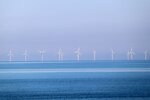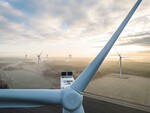04/26/2007
Small wind market takes off
Increasing numbers of homeowners, small businesses and farms are installing wind turbines to generate electricity. The growing number of states with tax incentives and net-metering programs is making residential wind power more feasible. Currently, there is residential wind power in 41 states, according to the American Wind Energy Association.
'In the last three years, all of a sudden there`s been an extreme increase in demand,' said Andy Kruse, co-founder and vice president of business development for Southwest Windpower. Increasing electricity costs, 50 percent to 70 percent spikes in deregulated states, concerns about stability and energy security and the 'tidal wave of people' looking at environmental issues are some of the reasons Kruse believes are behind the jump in small wind.
The consumer market, Kruse said, has really only developed during the past year. Southwest Windpower, along with the U.S. Department of Energy, developed the appliance-like wind turbine to meet those consumer needs. Just that one manufacturer sold 500 turbines in the past four months -- a 50 percent to 60 percent increase in business. Though many states, such as Hawaii, Massachusetts, Ohio and Vermont have strong state incentives, others have caps and other regulatory hurdles. While there are existing federal incentives in place for solar power, no such jump-start for the small wind industry exists, and residential wind turbines cost less than solar photovoltaic systems.
A bill introduced in the Senate earlier this year -- the Rural Wind Energy Development Act -- would provide $1,500 per one-half kilowatt of capacity for small wind systems for five years on all wind systems less than 100 kilowatts of capacity, with no cap on the amount of the credit granted per system. There is also state legislation in Illinois and Maine to promote wind power.
A typical residential wind energy system includes, on average, a 10 kilowatt turbine with 23-foot rotors mounted on an 80-foot tower. The systems, ranging from 100 watts to 20 kilowatts, are suitable for meeting the electricity needs of a household or small business. Smaller turbines are used on boats, to pump water from wells and on farms. Some of the systems are connected to the grid through net-metering, but there`s also a large market for off-grid systems that use batteries to store excess energy.
The idea of homegrown wind power is not new. The first U.S. wind turbines were built on farms in the 1890s and were used to generate electricity up until the 1920s and 1930s, according to the Energy Information Administration, the U.S. Department of Energy`s data arm. Hundreds of thousands of farmers, especially in the Midwest, used wind generators until dams built during the Great Depression put nearly the entire country on the electric grid system.
During the energy crisis that arose in the 1970s, consumers looking for cheaper, reliable electricity turned to small wind. When large-scale wind farms began cropping up in California, companies started buying, restoring and selling the older, smaller turbines to homeowners for profit. There are nine U.S. companies that manufacture wind turbines for residential use. While many of the design problems - aesthetics, noise at certain speeds, and maintenance requirements - have been rectified, there are still economic and siting issues that make small wind difficult.
Building height limits in many towns of 30 to 40 feet restrict wind turbines, which prosper at taller heights of 80 to 120 feet, especially when there are trees at lower heights. In suburban areas along the East Coast, homeowners` proposals for wind turbines must go before town boards where they can be turned down by neighbors. For those with more acreage, as in the Midwest, Southwest Windpower`s largest market, there aren`t the same space problems as in suburbia. Industry proponents push small wind for land plots anywhere from one-half to 1 acre, though some say in more populated areas 5 to 10 acres are needed before neighbors will give their approval. An average wind speed of 11 mph is recommended for a turbine.
Small wind energy systems cost from $3,000 to $5,000 for every kilowatt of generating capacity, or about $40,000 for a 10-kW installed system. Though cheaper than solar or hybrid systems, payback, with incentives, takes about 15 years. 'The greatest challenge is that it`s still not cost effective but we expect in the next five years that small wind will be cost effective for everyone,' Kruse said. Hardware costs have remained steady during the past 10 to 20 years and material prices have increased, especially in the last three years, but energy costs have come down. The cost of small wind-generated electricity has dropped from 15 to 18 cents per kilowatt hour to 10 to 11 cents and, Kruse said, the industry expects it to drop to 7 cents within five years.
'In the last three years, all of a sudden there`s been an extreme increase in demand,' said Andy Kruse, co-founder and vice president of business development for Southwest Windpower. Increasing electricity costs, 50 percent to 70 percent spikes in deregulated states, concerns about stability and energy security and the 'tidal wave of people' looking at environmental issues are some of the reasons Kruse believes are behind the jump in small wind.
The consumer market, Kruse said, has really only developed during the past year. Southwest Windpower, along with the U.S. Department of Energy, developed the appliance-like wind turbine to meet those consumer needs. Just that one manufacturer sold 500 turbines in the past four months -- a 50 percent to 60 percent increase in business. Though many states, such as Hawaii, Massachusetts, Ohio and Vermont have strong state incentives, others have caps and other regulatory hurdles. While there are existing federal incentives in place for solar power, no such jump-start for the small wind industry exists, and residential wind turbines cost less than solar photovoltaic systems.
A bill introduced in the Senate earlier this year -- the Rural Wind Energy Development Act -- would provide $1,500 per one-half kilowatt of capacity for small wind systems for five years on all wind systems less than 100 kilowatts of capacity, with no cap on the amount of the credit granted per system. There is also state legislation in Illinois and Maine to promote wind power.
A typical residential wind energy system includes, on average, a 10 kilowatt turbine with 23-foot rotors mounted on an 80-foot tower. The systems, ranging from 100 watts to 20 kilowatts, are suitable for meeting the electricity needs of a household or small business. Smaller turbines are used on boats, to pump water from wells and on farms. Some of the systems are connected to the grid through net-metering, but there`s also a large market for off-grid systems that use batteries to store excess energy.
The idea of homegrown wind power is not new. The first U.S. wind turbines were built on farms in the 1890s and were used to generate electricity up until the 1920s and 1930s, according to the Energy Information Administration, the U.S. Department of Energy`s data arm. Hundreds of thousands of farmers, especially in the Midwest, used wind generators until dams built during the Great Depression put nearly the entire country on the electric grid system.
During the energy crisis that arose in the 1970s, consumers looking for cheaper, reliable electricity turned to small wind. When large-scale wind farms began cropping up in California, companies started buying, restoring and selling the older, smaller turbines to homeowners for profit. There are nine U.S. companies that manufacture wind turbines for residential use. While many of the design problems - aesthetics, noise at certain speeds, and maintenance requirements - have been rectified, there are still economic and siting issues that make small wind difficult.
Building height limits in many towns of 30 to 40 feet restrict wind turbines, which prosper at taller heights of 80 to 120 feet, especially when there are trees at lower heights. In suburban areas along the East Coast, homeowners` proposals for wind turbines must go before town boards where they can be turned down by neighbors. For those with more acreage, as in the Midwest, Southwest Windpower`s largest market, there aren`t the same space problems as in suburbia. Industry proponents push small wind for land plots anywhere from one-half to 1 acre, though some say in more populated areas 5 to 10 acres are needed before neighbors will give their approval. An average wind speed of 11 mph is recommended for a turbine.
Small wind energy systems cost from $3,000 to $5,000 for every kilowatt of generating capacity, or about $40,000 for a 10-kW installed system. Though cheaper than solar or hybrid systems, payback, with incentives, takes about 15 years. 'The greatest challenge is that it`s still not cost effective but we expect in the next five years that small wind will be cost effective for everyone,' Kruse said. Hardware costs have remained steady during the past 10 to 20 years and material prices have increased, especially in the last three years, but energy costs have come down. The cost of small wind-generated electricity has dropped from 15 to 18 cents per kilowatt hour to 10 to 11 cents and, Kruse said, the industry expects it to drop to 7 cents within five years.
- Source:
- American Wind Energy Association
- Author:
- Edited by Trevor Sievert, Online Editorial Journalist
- Email:
- press@windfair.net
- Link:
- www.awea.com/...
- Keywords:
- wind energy, renewable energy, jobs, wind turbine, wind power, wind farm, rotorblade, onshore, offshore


























